MASQUERADE & DANCE OF DEATH. FRANCE & THE REPUBLIC IN TATTERS
A year ago the whole world was tuned in watching with dismay the fire devasting Notre Dame, France’s most potent symbol. The country was hit at its very core, Notre Dame is not only Paris’s but France’s Ground Zero. All French roads start from its forecourt, it is the symbol of the motherland dedicated to the Heavendly Mother crowned by Her Divine Son, its alpha and omega. There lies its heart and soul, its strength and its resilience.
A somber foreboding came over my soul and weighed down my spirit on this 15th of April 2018. Just as I had felt on the 7th of May 2017 on Emmanuel Macron’s election day as French President, as I watched him entering the Louvre courtyard as a ham actor stiffly imitating the stance of François Miterrand. I will protect you he had said to reassure the country, as I saw a black cloud gathering over his head. This sense of of impending doom came over me again as I was sitting in a sunny garden in the midst of the Fontainebleau forest in this fateful month of March 2020. As the Covid-19 epidemic was spreading, Macron had decided to confine older people ssupposely to protect them, at the same time to send them vote in the local elections on March 15th, thus hoping to reinforce his own party. In the future this decision will be seen as a fateful date for him, his Ides of March, when the self-proclaimed Jupiter, narcissic and perverse, stabbed himself with his destructive neoliberal politics and plunged the whole country into a tragic turmoil of death and suffering.
Since November 2017 the national Gilets Jaunes movement had been forecefully expressing in weekly demonstrations the deep discontent and social demands of the French people’s misery, subjected to the the government’s incompetent, incoherent and autocratic action in hurriedly imposing abusive social reforms. As a response Macron offered Le Grand débat,The Great Debate,to those he had treated with contempt ofGaulois réfractaires, defiant Gauls, insulted ceux qui ne sont rien, those who are nothing, and in reponse to the demands of the Health Service : je n’ai pas d’argent magique,I don’t have magic money. He then indulged in his taste for showbusiness and his favorite occupation, when he puts himself on stage for hours in shirt sleeves, arguing in endless monologues in answer to preselected questions from chosen spectators, thus avoiding any embarrassing and controversial subjects.
Of course nothing changed. In December 2019 and January 2020, as a result of a botched-up Pension Reform concocted in a rush and ruthlessly imposed, the public transport strike brought the whole country to a standstill. Trains, buses, trams, were packed with passengers who had been waiting sometimes for hours in the cold and wind on platforms and at bus stops. The French people did not complain but went on courageously with their work and business, celebrating Christmas in a spirit of hope and solidarity in hard times. They were already getting ready to face further hardship, and I heard many words, witnessed many an act of generosty and solidarity which moved me deeply. In January I could not stand the chaos and madness of it all any longer and I fled to the calm and peace of the country at Bois-le-Roi near Fontainebleau. There I worked for two months researching the life of a rather forgotten artist who had lived in the village in the second half of the 19th century. I had come across Georges Moreau de Tours in Paris, as I lived in his former home.
The first news of the Covid-19 reached me in the closed and privileged world of historical research which is mine. It has always been my refuge against the ugliness, violence and brutality of the world. In it I find poetic and artistic inspiration, creativity in writing as Baudelaire stated : Là tout n’est qu’ordre et beauté, luxe, calme et volupté, There is only Order, Beauty, Luxury, Calm and Delight .In January a Cabinet meeting supposedly held to discuss the Covid-19 epidemic had been highjacked by the higly contreversial Pensions Reform. The deadline set by Président Macron, self- appointed Jupiter, master of the clocks, had to be metagaisnt all odds. I will never forget on a visit in February Paris besieged, heavily armed soldiers in companies of eight or ten patrolling the streets, stations and boulevards. I will not forget either the closed up rue Royale where to reach the Madeleine and St. Augustin, I had to go through a narrow gate in a steel barrier three meters high controlled by the police and army. My heart froze. Paris, France, no longer belonged to the French people, but were submitted to dark repressive forces brutally forcing them into captivity. All joy of life, beauty and lightedness of heart and spirit were banished to further the political ambitions and financial interests of a grasping, immature and unstable man. Controlled by hidden multinational interests and supported by his hastily formed political party he was strangling the country with an iron fist.
A fateful cloud was overshadowing France imposing a new order. While working on Moreau de Tour I was also writing an article on Leonardo da Vinci and a contemporary French artist, Pierre-Yves Trémois,
I had noticed his illustration of Homer’s Odyssey dating from 1966 in his October 2019 exhibition in Paris, and I was looking at it now in a new light. This gigantic octopus standing for Scylla and Charybdis, chapter VI, a sea monster pierced by a spear while a man hides his face behind a corner of his tunic as a sign of dread, now seemed to me in the symbolic action of his gesture to evoke the horror of the plague hitting France and the rest of the world. The artist had added the verse : There are in the air of the day strange forces we do not know, the expression of man’s helplessness faced with a fate he has to confront and overcome in order to survive and fulfill his destiny.
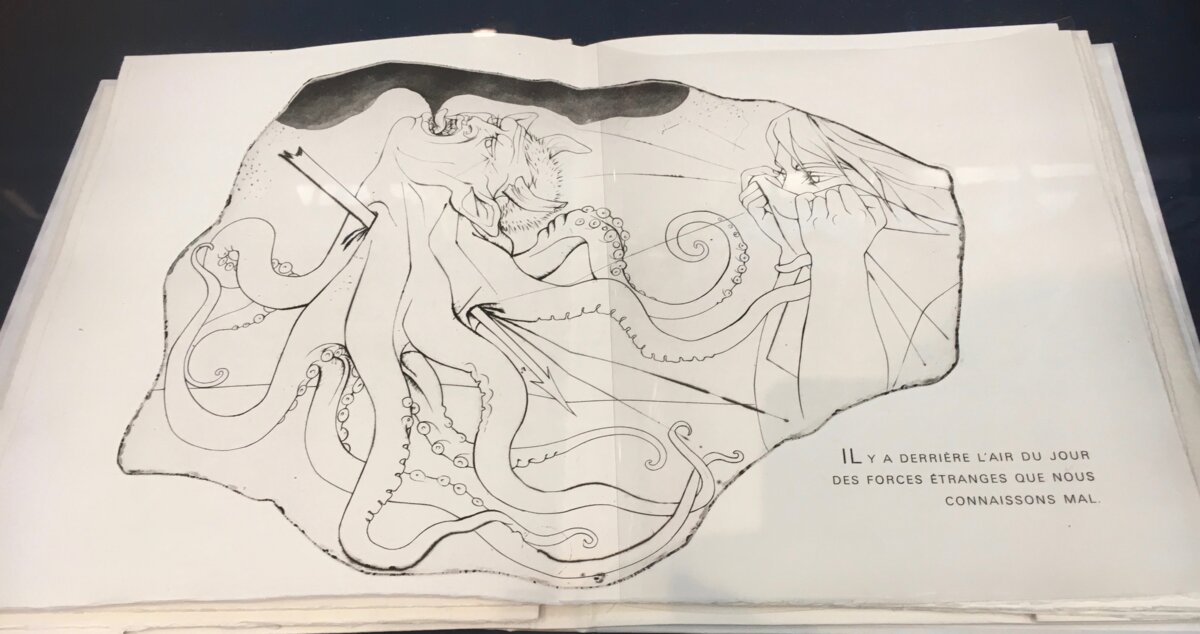
Agrandissement : Illustration 1

The shadow of death was darkening the day and changing the landscape. The sky was high and blue over the Fontainebleau forest and an early Spring was covering the underwood with the golden carpets of daffodils and primroses, of blue periwinkles, violets and wild anemones. The white prunus’s blossoms were bursting under the heat of the sun, charging the air with a heady honeyed scent. The intoxicating vibrations and emanations of Nature’s triumphant rebirth were those of an earthly paradise. Yet dark portents were overshadowing its splendour and could no longer be ignored, I could sense their urgency and foresee the gravity of their impact.
I followed the local elections campaign in Bois-le-Roi. There I witnessed all the general confusion and misunderstandings caused by the contradictory informations sent by the Government. Polling day was the priority before all public health considerations despite the first cases of infection, the first admissions in hospital, the first Covid-19 deceased, and the increased risk of contamination of elderly people previously told to stay confined for their protection. They were suddently released from confinement to perform their civic duty despite also the declarations of the former Health Minister, Anne Buzyn, who had become candidate to the Mairie de Paris. In January she had already warned the Government of the danger of a forthcoming epidemic, on March 11th she denounced the local elections as a masquerade. It was the appropriate description of a rapidly worsening sanitary situation. Taking into account the large number of abstentions and vast increase of cases the Government then decided to postpone the second ballot, and on March 16th announced a general and indefinite lockdown of the population.
The masquerade carried on : essential medical resources and equipment were lacking, hospitals were overwhelmed and coud no longer accommodate patients suffering from the virus who were sent to be treated in nearby Luxembourg, Germany and Austria. In this tragedy the masks were dropping, and the Governement’s inefficiency, incompetence and incoherence, as much as the lies and disinformations, were revealed. In the overcrowded hospitals the medical staff were not even able to wear masks to protect themselves and the patients. For years France had relocated its factories and industries in Asia, now the Government had to pay top prices to China for essential drugs and other medical equipment and for the infamous masks the French authorities, despite all common sense and medical advice, still persist in declaring unecessary against contamination. No doubt this obvious bad faith is aimed to cover up the present Government’s lack of stocks and its basic inability to protect the citizens, Macron and his Party have no sense of the responsablities inherent to their roles and no civic empathy. The missing protective masks situation results from a lack of political interest in the matter as much as of anticipating and planning the sanitary emergency. But there is also perhaps a very French psychological enigma in this matter, which can be linked to the question of the Muslim women’s veil, a political issue in this country. In recent years it has become a national obssession, to the astonishment of the rest of the world. It is linked with the rampant anteclericalism of the French Revolution, when during the Terror, nuns who had taken the veil were presecuted and put to death as in Poulenc’s opera, Le Dialogue des Carmélites. The 1905 law over the Separation of the State and Church, supposedly establishing a reasonable form of laicity, is in fact the pretext to conceal a latent atheism and the source of a witch hunt against all forms of religious expression or behaviour in French society. The veil, and hence by unconscious assimilation the mask, are thus hated and banished. I was meditating on those hidden motivations in the national French spirit, vehemently denied by those concerned and which I have been trying to decipher ever since I came back to my motherland, as I left Bois-le-Roi. This ancient and secret celtic land for centuries of a rebellious spirit, had welcomed after the 1870 war a colony of artists, poets and writers fleeing from the chaos and hardships of the Paris siege and the Commune, in which some of them had participated. I had made it the subject of my research for two months, now I had to return to the present days’ harsh realities and live the lockdown in Paris.
Pondering on the present epidemic I went back to the Late Middle Ages and the First Renaissance at the time of the Black Plague in the 14th century. I was struck by the similarities with the Covid-19 : both pandemics came from Asia, both had started in Lombardy, the trade centre on the Silk Road along which the Black Plague had travelled. Both were of animal origin, the fleas of the rats infesting the Genoese ships had spread the virus all over the Mediteranean from Sicily to Genoa, Venice and Marseille. From 1347 to 1351, as in Asia the Black Plague devastated Europe and North Africa, decimating more than a third of Europe’s population. As with the Covid-19, from its geographical situation and trade with the East, Northern Italy was the first hit, then the epidemic spread to Northern Europe. This was not the first plague, it had already caused devastation in Antiquity at the time of the Roman Empire, the Plague of Justinian had hit in the 6th century BC and Seneca in the 1st century had described a similar epidemic. Its name, Black Plagueor Black Death, came from Homer who used it in the Odyssey to describe Scylla with her mouth full of black death. Trémois depicted her in his engraving as a gigantic octopus with black ink oozing from her mouth, illustrating the colour black both literaly and figuratively, in the sense of what is dreadful and causes terror.
If plague epidemics repeatedly hit worldwide until the beginning of the 20 th century, the first one in the United States in San Francisco from 1900 to 1904 and the last one to date in Madagascar in 2017, the Black Plague’s aftermath had a very important social, political and economic impact on the Medieval world, altering the geopolitical map. The Near East, the Middle East and North Africa were severely hit, repeatedly so every year from 1500 à 1850, the weakened Byzantine Empire fell under Ottoman rule. In France the standard literary and artistic references to the plague are Albert Camus’s La Peste, The Plague, written in 1957 and inspired by the Algier’s epidemic in 1944 that of Oran in 1945, and Gros’s painting to the Napoleonic propaganda in the Louvre Museum showing Bonaparte visiting the Les pestiférés de Jaffa, The Plague Victims of Jaffaon the 11th of March 1799 in the military hospital of the Syrian city’s lazaret located in the Armenian Saint Nicholas Monastery.
However the most influential work inspired by the Black Plague is Boccaccio’s Decamerone, also called L’umana commedia, The Human Comedy, Boccaccio was a humanist and friend of Petrarch, in his book he turned to the past in form and content, emulating Paul the Deacon in his description of the plague, a benedictine monk who recounted in the 8th century a similar epidemic in his History of the Lombards.
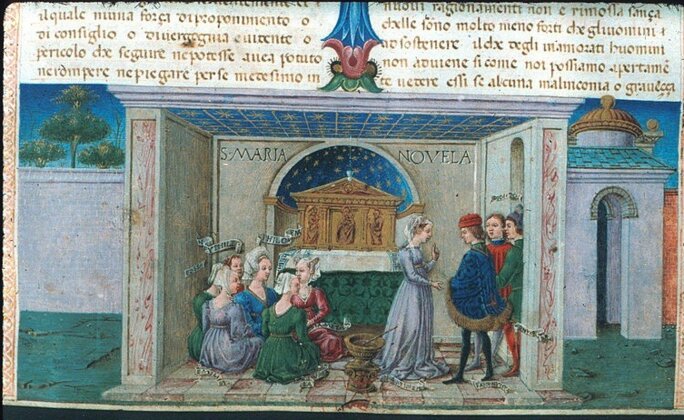
Agrandissement : Illustration 2

The narrative conceit of seven women and three men locked up for a fortnight in a villa in Fiesole, every night inventing a tale on a chosen theme, is taken from a collection of Indian fables. The sanskrit text dating from the 6th century had come to Italy in various translations : Old Persan, Hebrew, Greek, Arab and Latin. The hundred tales, some of them featuring historical figures, are also derived from ancient tales, novels and fables. They come from various sources : Classical Greece, the Middle East, the Iberian Peninsula as much as from oral tradition so the author tells us. The various aspects of human nature expressed in their most noble or vile aspirations create a Human Comedy set in the framework of the plague, carried through the wisdom of a universal knowlege. Medieval society is depicted with flair, humour, scholarship andsophistication in the stage set of an earthy paradise ruled by Eros. In the antique manner love is described under all its aspects, from courtly love to carnal love, from venal love to perverse love, from coarse love to transcendent love.Man is at the centre of nature, he belongs there, he deeply feels it. He reverently describes its splendour and its beauty, Nature rules over all as the author states in his introduction to the Fourth Day : E sentì incontanente piú aver di forza la natura che il suo ingegno. He immediately felt that Nature’s power was greater than his own cleverness. Womanhood is exalted throughout, the author dedicates his book to a feminine public. The four women are the instigators of this life experience, yet wisely decide to include three men : Without doubt men rule over women, and if they do not put our enterprises in good order, we shall not succeed in carringy them through honorably … The Decameron, First Day. The feminine characters stand for the FourCardinal Virtues : Prudenceor Sophia, Wisdom, Justiceor Uprightness, Temperanceor Self Control, Fortitude or Courage, according to Plato’s Republic, the Bible and the Church. While the three men stand for the Three Theological Virtues : Faith, Hopeand Charity, consistent with the spirit of the time when the Church was a temporal and political power. Another reading could allude to the classical tradition of the Seven Liberal Arts according to Boethius’s conception. The 8th century Roman philosopher classified them in their highest manifestation as the Quadrivium : Arithmetic, Geometry, Music and Astronomy, all deriving from the Pythagorean concept of harmony ruling over the world, a feminine quality, while the Trivium stands for the masculine element : Grammar, Logic, Rhetoric or else Plato’s three components of the human soul : Reason, Spirit, Desire.
While borrowing Dantes’s medieval mysticism allying allegory, metaphor and the Hermetic tradition of the sacred in stars and numbers, the tales are not didactic but satirical. In a learned and sophisticated framework human destiny is depicted as ruled by the vagaries of the Wheel of Fortune, Rota Fortunae, inspired by the Indian Samsara and the Hermetic tradition as expressed by Boethius locked in prison in his Consolation of Philosophy. Fate’s pitfalls and trials are described with humour in a satirical note and directed mostly against the dark side of the feminine nature and the ecclesiastics’ excesses, both themes taken on by Chaucer in theCanterbury Tales and by Shakespeare. The satiric mode, a release from suffering and human folly, is inherent to the medieval spirit. It is the expressions of a vigorous spirit and fortitude in front of human foibles, adversity, injustice, misfortune and death. Faced by the plague all are concerned : How many valiant men, beautiful women, gracious youths have been carried away, who would have been certified in good health by anyone, not counting Galen , Hippocrates or Asclepius, who had broken fast in the morning with their family, companions and friends, and at night dined in the other world with their dead ones.The Decameron, First Day.
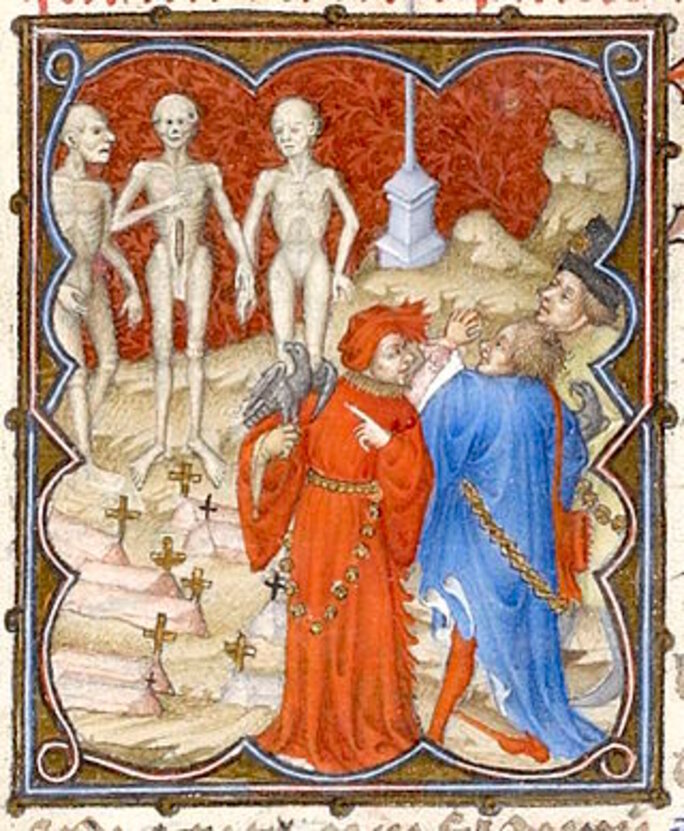
The satiric mode on Death’s unavoidable stroke was first used in Flanders at the end of the 13th century in short poems called Dits, Spoken words. Baudoin de Condé, minstrel at the court of Marguerite II, countess of Flanders (1244-80) created the genre with panache in a short lively satirical poem telling of the meeting between three Vifs, Living :prince, duke et count and three Morts, Dead. Memento Mori, Vanitas vanitatum et omnia vanitas, all is vanity and the end ineluctable however high and mighty one might be.The theme can also be found in the Roman de la Rose, The Romance of the Rose by Guillaume de Loris and Jean de Meung ( 1230-1280), and the Book of Hours of the time. Thus in Les Petites Heures du Duc de Berry, illustrated by Flemish masters such as Jacquemart de Hesdin et les Frères Limbourg from 1375 to 1415. The Dit theme was also used in churches’ murals for the first time in the Notre-Dame des Doms cathedral in Avignon.
The Danse Macabre, Dance of Death, of the Innocents’ charnel in Paris, situated on an ancient Merovingian funerary site, was a more accomplished variation on the Dit theme. As Boccaccio’sDecameron it staged all the protagonists of contemporary society, including the new trades created by Medieval urban development. It was realized during the Hundred Years War from 1424 to 1425 and consisted of an anonymous mural painting and a commentary in verse attributed to Jean Gerson. The Danse Macabrehas its origin in the Mystères, Mysteries,the 15th centur
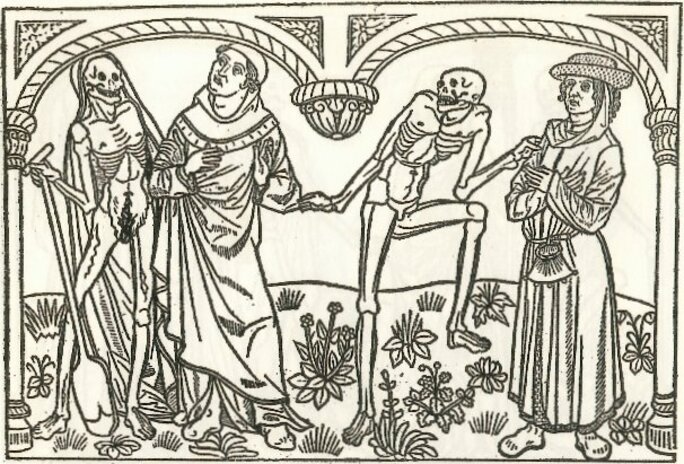
Agrandissement : Illustration 4

y popular theatricals where mystical and religious supernatural plots mixed with down to earth realism were performed in sketches commented by a dialogue. Such a parformance was given at the Saints Innocents church in commemoration of the deceased. The strongly satiric verses, the imaginative and humoristic representation of the farandole of the twenty four characters challenged by Death, who appeared in the Carnaval’s procession, recalls the Dits des Trois Vifs et des Trois Morts carved by order of the duc de Berry on the portal of the Saints Innocents church in 1405. Although the wall of the Danse Macabre was pulled down in 1669 to widen an adjoining street, its art and message seemed barbarous to Louis XIV’s France compared to Versailles’s Baroque pomp and splendour, it has survived in several manuscripts. One version in verse survives in Paris at the Bibliothèque Nationale de France, another one published in 1485 with verses and engravings by the printer Guyot Marchant is in the Bibliothèque de Grenoble. To start with the narrator speaks to the reader as if in a sermon, the theme of the vanities of earthly life and death as a great leveller had been promoted by the Mendicant Orders, the Franciscans and the Dominicans, Friars Preachers.
Narrator
O thee creature of reason
Who longest for eternal life,
Hear this lesson worthy of attention
To end well thy mortal life.
It is called the Dance of Death :
All learn how to dance on its tune,
It as is natural to man as to woman.
Death does not spare any small or great.
In this mirror each one can read
That one day he will have thus to dance.
Wise is the one who gazes well !
Death leads the living ;
Thou canst see the mighty go first.
For there is no one Death cannot vanquish.
It is pity to think of it ;
All is forged of the same stuff.
The verses comment the scenes under each illustrations of the dialogue between Death and the Living depicted two by two between two columns recalling the charnel’s cloister arcade. The representation of the Living alternates a cleric and a layman, in the Middle Ages lettered members of society such as Teachers, Doctors, Lawyers were considered as clerics. Among the characters in the farandole : the Pope, the King, the Bishop, the Doctor, the Lawyer, the Courtier, the Peasant, the Child etc. here is the Burgher whose financial cares are most representative of Emmanuel Macron’s character, the present French President. He is paired with the Scholar, as an arrogant show-off.
Death
Come along Burgher, do not dither,
Thou hast no goods nor riches
Which can protect thee from Death.
The wordly goods thou wast given so generously
If thou hast used them well, with wisdom,
What comes from others goes back to others
Folly it is to kill onself to gather
One does not know for whom one is hoarding.
The Burgher
It grieves me to leave so soon
Incomes, houses, taxes and provisions.
But Thou lowerest the poor and the rich
Death ; such is Thy nature
It is not wise for us creatures
To love too much one’s wordly goods
They belong righltly to the earth
To those who have much, Death is much.
The Child is included in the Dance of Death but Woman is spared. It reflects the influence of Courtly Love inherited from the Muslim courts of Baghdad and Cordoba. It was introduced by minstrels and troubadours in the Courts of Love first in Provence, and in Aquitaine under the influence of Alienor of Aquitaine, before spreading to the Northern courts. This devotion to the feminine principle endowed France with its churches and cathedrals all named Notre Dame, showing on their tympanum as in Paris, the Coronation of Our Lady by her Son.
The Paris Danse Macabresoon became famous in the whole of Europe, most likely the English and Burgundians’ occupation of the French capital contributed to this fame, the hôtel de Bourgogne was situated in the Saints Innocents’ neighbourhood. Several mentions are made in the Journal de Paris, 1405-1449, it was reported that a Franciscan at the Burgundian court preached there. John Lydgate, an English friar, also poet and admirer of Chaucer, was persuaded by French clerics, so he tells us to translate the verses.The Dance of Death was reproduced in London c. 1430 with his translation on the wall of the Pardon cemetery of the Old Saint Paul’s Cathedral, and destroyed in 1549. More that ninety versions still survive in France, and the topic spread to Flanders, Northern Italy, Germany, Switzerland and as far as Denmark.
The Vanitas theme of human folly inspired a scathing satire The Ship of Fools, an allegory by the Strasbourg humanist and poet Sebastian Brandt. His famous satirical poem was published in German in Basle in 1494 at the time of Carnival. The volume is illustrated with woodcuts attributed to the young Albrecht Dürer.This sharp satire of human folly depicted through contemporary European Renaissance society enjoyed an immediate popular success. As a result is was first translated in latin the lingua franca of the time in 1497, and in all other European languages : in French by Pierre Rivière in 1497, in Flemish at s’-Hertogenbosch in 1500 and in English by Robert Barclay in 1509. The hundred and three poems are illustrated with hundred and seven woodcuts each depicting a form of folly. The trope, or allegory, describing a ship without pilot taken over by maddened giddy passengers, without sense nor discrimination, thoughtless and irresponsible in their actions, leading the ship to be wrecked, was common at the time. It goes back to Plato’s Republic, chapter VI, a satire on the art of governing countries and men.
Hieronymus Bosch’s Ship of Fools c.1500 in the Louvre Museum is similar to the frontispiece of Brandt’s volume.
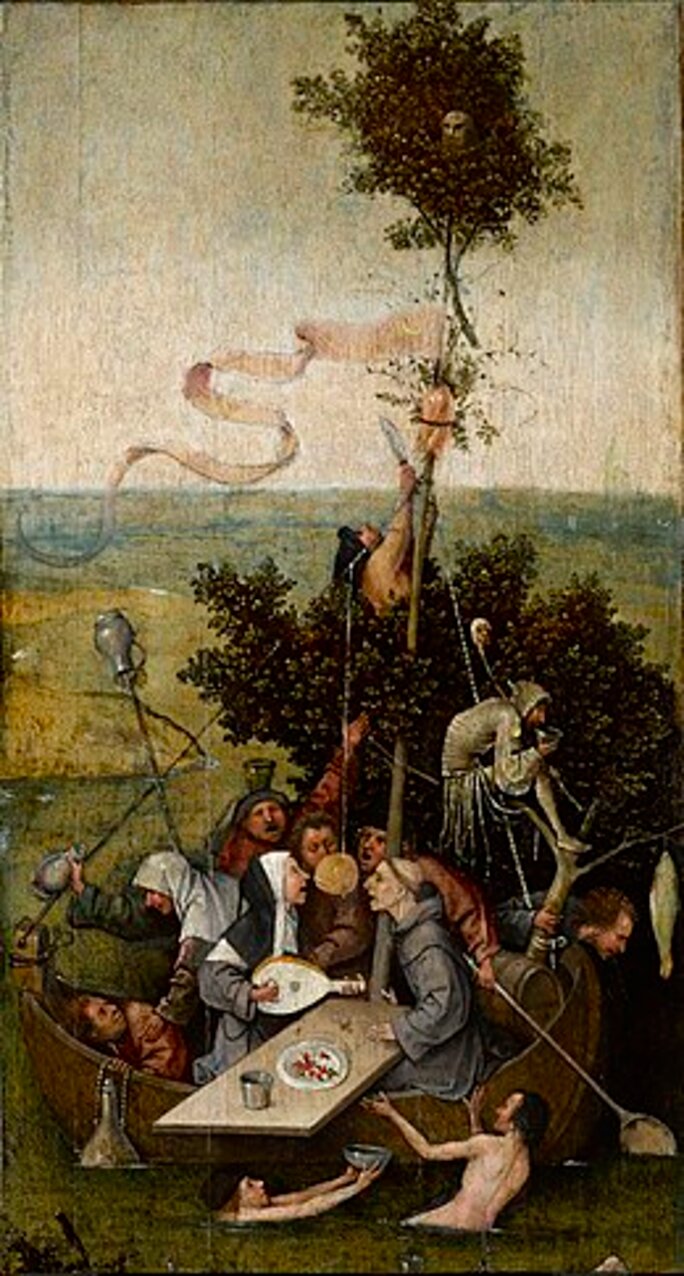
Like many notables of his time Bosch belonged to a brotherhood, The Illustrious Brotherhood of Our Blessed Lady, dedicated to the Virgin. It was altogether an honour and a civic duty. The members were bound to support financially the charitable actions they also had to perform, according to The Seven Acts of Mercy, as stated in St. Matthew’s gospel : To feed the Hungry, to give drink to the Thirsty, to clothe the Naked, to shelter the Homeless, to visit the Sick, to visit the Imprisoned, to bury the Dead. Bosch’s works like Brandt’s Ship of Fools is satirical and didactic, aiming to make men conscious of their own folly in ignoring the results of their spinelessness and weaknesses, their excesses, their vices and dishonorable behaviour.
Five hundred years later human condition has remained the same. The same politico-religious conflicts inflame and destroy whole countries, scattering away populations on land and sea, creating the same hatred, the same misery, the same despair. Or should one say that human folly has worsened ? Nowadays no one ventures to publically denounce it any longer, yet it is not only one country, one region, one continent which is threatened, but the whole planet in the blind suicidal race to the gratification of materialism and consumerism, power and greed’s selfish needs. The Covid-19 pandemic is a direct result of a frantic and reckless neoliberal globalization. The spirituality of the Medieval and Renaissance humanists, poets and artists does not exist any longer, the cult of Mammon has replaced it. To such an extent that respect to the dead is no longer honored in France, a Christian country historically The Eldest Daughter of the Church. Of all the many faults committed by the Macron Government none can compare with the ignominy attached to the interdiction of burying the dead with dignity. These hurried funerals with only a priest, iman or rabbi allowed, assisted by four funeral attendants without the homily, the prayers, the tears which must accompany the deceased to their last resting place, will remain a permanent stain on the national honour. It will stand as the French President’s cardinal error, he who has commited many others, yet they fade in comparison with this contempt shown to one of the most sacred human duty, honoring our dead, a quality that distinguish man from the beast.
There will be immense repercussions and grievous consequences. The deceased, which the Government exposed without a qualm to contagion in sending them to vote in the local elections, now useless are thrown away as an out-of-date product of consommation. Words fail in front of such cynicism, such total lack of humanity, of feelings, let alone of ethics and spirituality. According to official reckoning the flow of customers can easily be accomodated in supermarkets, but not the family and friends grieving their dead ones in a funeral ceremony complying with security norms ! Those who are thus deprived of the funerary rituals, as essential to the living as to the dead, will forever bear in their heart and soul the sorrow of the trauma and a much longer period of bereavement. Death is ominipresent in this pandemic, yet it remains a tabou although it is an inherent part of life. Life itself can be seen in philosophical terms as a series of metamorphoses through which man as a butterfly dies to himself to be reborn anew, from childhood to youth, from maturity onto old age. It is a long or for some a short initiatic path towards death, in which all stages have the same importance and the same value, they must all be lived through and honoured. The Ancient World knew this and made it their wisdom. The denial of death, the refusal to face what is ineluctable shows the superficiality of an immature spirit and a lack of wisdom. It is the sickness of the modern world all taken by the demands of wordly concerns at the expense of the contemplation of inner life. I witnessed this when I looked after my mother-in-law suffering from cancer, she was over eighty years old and I had not yet reached my thirtieth birthday. I was then physically faced with death for the first time and I was honoring the duty to care for the sick and bury the dead according to the Seven Acts of Mercy.In performing her funeraty toilette I prepared her with love and respect to her eternal rest. She had never shown any good will towards towards me, and her malice did me much wrong after her death, yet I had made her look beautiful for her last farewell to her sons. She was very conscious of her looks, she knew she could rely on me and had given me instructions before her passing away.
In a materialistic and atheist world ruled by market econony and frantic consumerism death is no longer perceived and honored as in the past. It has been sterilized, disconnected from life and the emotions by modern science and technology. In the worse cases it has even become a product to buy. Like having to pay 55 euros to bid a last farewell to a loved one deceased from the Covd19, now parked in a storeroom in Rungis without being able to have a funeral ceremony worthy of the name. Death has become a virtual experience, an entertainment one can watch on a screen in technicolor in the cruellest, crudest details. But what has become of its emotional and spiritual impact on the living, of the bonds which unite the living to the dead, who in death are entitled to be honored in memory ? Whether they be of love or of hatred, and Love is always stronger than hate, Omnia vincit amor, as is Good over Evil, these bonds are real and essential to the living’s psychological health. Until recently the French knew better. In the middle of the 19th century France was at the forefront of psychic and psychological research with the works of Jacques-Joseph Moreau de Tours (1804-1884), and Jean-Martin Charcot (1825-1893) on hypnosis and hysteria leading to the theory of psychological trauma at the hospital of the Salpêtrière, which had a major influence on Sigmund Freud as a student there. The father of George Moreau de Tours was a pioneer in psychiatry. He demonstrated the negative effects of bereavement and emotional shock on the human psyche rendering it vulnerable to psychological disorders. And to prove his theory of madness, for him a state of frenzy akin to a dream, he studied and experimented with the effects of cannabis and and hashish on the central nervous system during a journey to the Near and Middle East 1834-40. Back in Paris he created theClub des Hashischinsin 1844, a meeting place for artists and poets, to further and endorse his research.
The French people locked in a pandemic, by no means unprecedented since it shows many similarities to past epidemics such as the Black Death, are given no real support from the State to alleviate their physical and moral distress. Instead they are being patronized by contradictory and confusing official declarations meant to make them feel guilty and to manipulate them for political ends. Who will denounce this disgrace ? In the future a great upheaval will result from it all in a reversal of priorities and a return to the fundamentals. Popular common sense already start perceiving the vanity of all the trappings of modern life. It is certainly not technology, artificial intelligence and robots which can feed bodies and comfort souls, even if they can be of help in the medical field. The big cities with their energy-consuming skyscrapers will not produce the food necessary to survival. It is Mother Nature as a bountiful protector and provider who will sustain man if he repents of his errors and make amends. Nature will always be the strongest. Primum vivere, deinde philosophari, First to live then to philosophise used to say my philosophy professor then over seventy years old. The present pandemic brings to the fore those who have ethics, respect for life within themselves and around them, respect for death itself, as it is part of their daily experience : doctors and other health practionneers, but also farmers working the land. They are aware of basic needs and challenges unknown to city-dwellers now anxiously locked up in their sterilized town interiors.
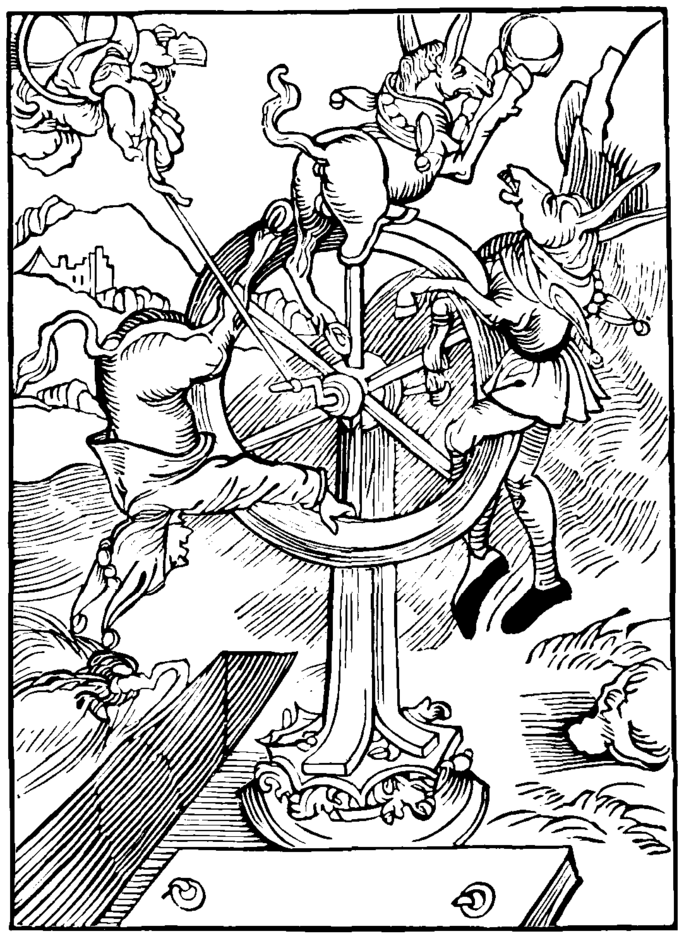
Agrandissement : Illustration 6

In 2016 I had aleady used the Ship of Fools allegory at the time of the terrorist attacks in Paris. Then the French President François Hollande was talking of a war in adopting a belligerant stance to gain in dignity and political credibility. Emmanuel Macron does the same in the Covid-19 pandemic. He should do well to meditate on Brandt’s Human Follies in Robert Barclay’s translation, Folio 111, Of the ende of worldly honour and power and of folys that trust therin. It shows donkeys tied up to a wheel, the Wheel of Fortune, which always ends up by turning..
https://blogs.mediapart.fr/monique-riccardi-cubitt/blog/100416/ship-fools
As to the Folly of having elected Emmanuel Macron President of the French Republic it could be said :Of the Folly of electing an immature and perverse man, to grant him all Powers and put him at the Helm of the Ship, which he leads to the Rifs and to its Wreck.
Those passengers of The Ship of Fools, blind and uneducated, ignorant of themselves and of others, of their heritage, mad men without a vision of the future, sailing to their own demise, should do well to meditate the first Lauda, Praise of the 13th century Umbrian franciscan friar, poet and mystic, Jacopone Da Todi: La Prima Lauda del Libro di questa Morte : Armate, omo, che se passa l'ora. The First Praise of the Book of this Death : To Arms, man, the Hour has come ! For man is an infinitely perfectible being as Pico de la Mirandola stated in Oration on the Dignity of Man1486. Marguerite Yourcenar included it in her book l'Oeuvre au Noir, The Abyssor Zeno of Bruges in English : I have made you neither of the earth nor of heavens, mortal or immortal, so that you can freely in the manner of a good artist or a skillful sculptor create your own form. Boethius said it in his Consolation of Philosophy : Mankind is meant to achieve perfection, drawing from the Hermetic Tradition’s teachings that history repeats itself, time always returns. Such as the Ancient Greeks’Ouroboros cycles succeed to cycles as long as this aim is not reached. This pandemic heralds the end of a cycle, the end of a particular world, the unbriddled world of neoliberaalism destroyer of such much for the sake of profit and market economy. As the Renaissance succeeded to the Black Plague, on the ruins of the Old World, represented in France by Macron, a new world will be built where humanism will once more asserts its power and take preeminence over money, profit and false values. Man and his essential and legitimate needs will once more be the centre of life. In dark times Katherine Mansfield’swords engraved on a rock in the Fontainebleau Forest where she stayed, must resonate : Life never becomes a habit, it remains a marvel. Mankind and the whole world engulfed in the anxiety, the fear and loneliness of this forced lockdown, must return to the fundamentals. It is of the utmost importance that they recapture this quality of wonderment in life, a simplicity and generosity of heart and spirit to find their own soul again in the love of life itself, of the world as a whole, of other human beings. And then in the words of Christ recalled from her visions by the English mystic and anchorite Julian of Norwich (1342- 1416) in her Revelations of Divine Love : All shall be well, and all shall be well, and all manner of thing shall be wellsince it is part of the Divine Plan.
Monique Riccardi-Cubitt.
Paris, 7th of May 2020



